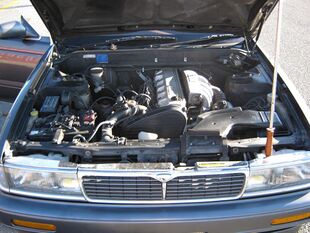Engineering:Nissan RD engine
| Nissan RD engine | |
|---|---|
 RD28 series 1 in a C33 Nissan Laurel | |
| Overview | |
| Manufacturer | Nissan Diesel |
| Production | 1985-2009 |
| Layout | |
| Configuration | Straight-6 |
| Displacement | 2.8 L (2,826 cc) |
| Cylinder bore | 85 mm (3.35 in) |
| Piston stroke | 83 mm (3.27 in) |
| Valvetrain |
|
| Combustion | |
| Turbocharger | With intercooler on RD28T and RD28ET |
| Fuel system | Mechanical fuel injection Electronic fuel injection |
| Fuel type | Diesel |
| Cooling system | Water-cooled |
| Output | |
| Power output | 94–145 PS (69–107 kW; 93–143 bhp) |
| Torque output | 18–29.3 kg⋅m (177–287 N⋅m; 130–212 lb⋅ft) |
| Chronology | |
| Predecessor | LD and SD |
The Nissan RD engine series is basically a Nissan RB engine design, except that it is only a single overhead cam six-cylinder diesel engine. It was the successor to the Nissan LD and SD six-cylinder engines and was joined by the six-cylinder Nissan TD engine.
From 1997 onwards the turbocharged versions were fitted with electronic fuel injection. The turbodiesel version known as the RD28T (or RD28ET with electronic fuel injection) and were also fitted to the Nissan Safari (also known as the Nissan Patrol) off-road vehicle.
Since the Nissan RD engine is based on the Nissan RB engine, they have many similarities and many parts are interchangeable. The engine block was similar to the RB30 engine except it had more material, was heavier and had 85mm bore vs the 86mm bore of the RB30 and a 83mm stroke vs 85mm stroke. One issue is that the stronger vibrations from the diesel engine can loosen the crank/harmonic balancer bolt (originally from the RB engines) and in turn become loose or fall off causing major engine damage. It is recommended to use thread locking fluid when installing.
The cylinder head was of a non-crossflow design, meaning that the exhaust and intake ports were on one side of the cylinder head.
RD28
- 2.8 L (2,826 cc) SOHC, 85 mm (3.35 in) bore
RD28 Series 1
- 12 valves (two per cylinder). When originally introduced, JIS gross were used rather than JIS net, meaning that early information claims 100 PS (74 kW; 99 bhp) and 18.5 kg⋅m (181 N⋅m; 134 lb⋅ft) at the same engine speeds.[1]
94 PS (69 kW; 93 bhp) at 4,800 rpm
18 kg⋅m (177 N⋅m; 130 lb⋅ft) at 2,400 rpm
- Nissan Skyline R31 series 1985–1987
- Nissan Laurel C32 ~ C34 series 1986–1993
- Nissan Cedric / Nissan Gloria Y30 ~ Y32 series 1985–1993
- Commercial (taxi) Nissan Cedric / Nissan Gloria Y31 series sedan 1987–1999
- Nissan Crew K30 series 1993–1999
- Nissan Cefiro A31 series 1988–1993
No PCV on the tappet cover.
RD28 Series 2
100 PS (74 kW; 99 bhp) at 4,800 rpm
18.2 kg⋅m (178 N⋅m; 132 lb⋅ft) at 2,400 rpm
- Nissan Cedric / Nissan Gloria Y32 & Y33 series 1993–1999
- Nissan Laurel C34 - C35 series 1994–1999
RD28E
100 PS (74 kW; 99 bhp) at 4,800 rpm
18.2 kg⋅m (178 N⋅m; 132 lb⋅ft) at 2,400 rpm
- Commercial (taxi) Nissan Cedric Y31 series sedan 1999.08-2002[2]
- Nissan Laurel C35 series 1999–2001
- Nissan Crew K30 series 1999-2009
Vacuum pump located on tappet cover.
RD28T
- 2.8 L (2,826 cc) SOHC turbodiesel
125 PS (92 kW; 123 bhp) at 4,400 rpm
26 kg⋅m (255 N⋅m; 188 lb⋅ft) at 2,400 rpm
Nissan Safari Spirit series Y60 2-door soft-top 1996–1997
Nissan Civilian Bus
RD28ETi1
- Electronically controlled turbodiesel with an intercooler
135 PS (99 kW; 133 bhp) at 4,000 rpm
29.3 kg⋅m (287 N⋅m; 212 lb⋅ft) at 2,000 rpm
Nissan Safari Spirit series Y61 2-door soft-top 1997–1999 (automatic transmission)
RD28ETi2
- Electronically controlled turbodiesel with an intercooler
145 PS (107 kW; 143 bhp) at 4,000 rpm
26.6 kg⋅m (261 N⋅m; 192 lb⋅ft) at 2,000 rpm
See also
References
- ↑ Büschi, Hans-Ulrich, ed (5 March 1987) (in de, fr). Automobil Revue 1987. 82. Berne, Switzerland: Hallwag AG. p. 428. ISBN 3-444-00458-3.
- ↑ "Goo-net Catalog: Nissan Cedric Classic". Goo-net. http://www.goo-net.com/catalog/NISSAN/CEDRIC/1505411/index.html.
 |

